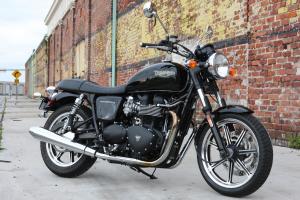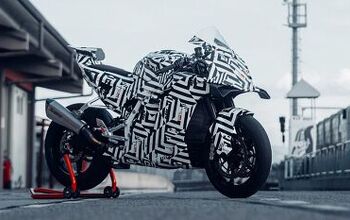Safety Series: Bike Selection
Motorcycle.com is putting together a safety series of articles for the month of July. For our first article, our topic is bike selection. Whether you’re new or experienced, cruiser or racer, in order to stay safe and enjoy the ride, it helps to pick the right bike for you. By now we’ll assume you’ve already completed a motorcycle safety course (if you haven’t, do it!) and are ready for the open road.
Here we’ll break down a few different motorcycles based on experience levels and type of usage. We’re keeping this list limited to current models, but there are a plethora of motorcycles from yesteryear that shouldn’t be overlooked. Later we’ll discuss the ongoing progression of technology in motorcycling, specifically in the form of rider aids.
Anti-lock brakes, traction control and power modes are three such aids that are becoming more prevalent on today’s machines. We’ll highlight them and explain why they contribute to a safer riding experience. But first, let’s talk bikes.
Beginner Bikes
If you’re a new rider, you’ve picked a great time to be involved with this sport. Many manufacturers are offering beginner-friendly machinery these days, hoping a pleasant experience on their first bike might lead to brand loyalty. So what should you look for in a beginner bike? We recommend a machine with manageable engine power, comfortable ergonomics and light weight.
One of the most popular beginner bikes, and one that meets all the aforementioned criteria, is the $4449 Kawasaki Ninja 250 (also known as the EX250). A part of the Kawasaki lineup since the Reagan administration, the little Ninjette has earned its status as a noob-friendly motorcycle through its completely non-intimidating stature. With about 25 horsepower, the 250cc engine produces docile power for a new rider of average stature. Perfect for learning proper throttle control.
The Ninja 250 got a major update in 2008, and you can read about all the details in our reviews here and here. A low seat height inspires confidence by enabling new riders to put their feet down comfortably. A slightly sporty seating position is still comfy, yet places a rider in a position to practice slow-speed maneuvers with ease. To us, the little Ninja is a great bike for new riders looking to learn.
However, there are other machines equally as capable. The $4099 Honda CBR250R is a direct competitor to the Ninjette. The CBR offers performance and dimensions similar to that of the Kawasaki. Our very own resident noob, Dennis Chung, took the CBR for a spin recently, which you can read about in his report here.
A Korean alternative to the aforementioned Japanese brands, we tested the Hyosung GT250 here. The GT250 costs slightly less than the Honda and Kawasaki, but its larger dimensions are more suitable for taller or bigger riders. In fact, check out our 2011 250cc Beginner Bike Shootout to see exactly how the three stack up.
If sporty bikes aren’t your thing, many manufacturers make beginner cruiser models as well. The $4190 Honda Rebel and equally priced Star V-Star 250 are two such motorcycles. Designed with the noob in mind, each motorcycle makes great learning tools, with many of the attributes that make the Ninja and CBR 250s excellent beginner bikes, except with a decidedly relaxed, cruiser tilt.
The Star’s 249cc V-Twin is 10cc larger than the Honda’s Parallel Twin and thus has a slight power advantage, but both are inviting for new riders. Read how the two rate against each other – and the Cleveland Cyclewerks, Tha Heist – in our 250cc Cruiser Review.
For some, the allure of a Harley-Davidson is too much to resist. Nothing else will do. While we don’t necessarily recommend a Harley as a first bike because they are significantly heavier than the others listed here, if you insist on some Milwaukee muscle, and are of bigger stature, give a look to the Sportster Superlow or Iron 883.
While each are heavier and more powerful than the other machines listed so far (making about 46 horsepower), the 883cc, air-cooled V-Twin powering both bikes is still a relatively tame engine that produces the distinctive H-D thumpity thump we all know. Both are ergonomically neutral, and $7,999 for either machine, make for modest entry into the world of Harley-Davidson.
Somewhere in the middle of the spectrum are standard motorcycles like the $4099 Suzuki TU250X. The “standard” name comes from a combination of factors, but generally speaking, these motorcycles have neutral, upright seating positions and don’t have sporty or cruiser-like pretenses in their design.
The Suzuki is fairly simple with its single-cylinder, fuel-injected engine, which makes for easy startup. Plus, it’s genuinely fun to ride. Like the other beginner bikes in this section, it benefits from a low(ish) seat height hovering around 30 inches and manageable power (about 16 horses). At 326 pounds it’s rather light for the class as well.
What all these motorcycles (and others in this class) have in common is an emphasis on being inviting to new riders. Manageable power allows the new rider to understand throttle control without being overwhelmed. Low seat heights enable riders to firmly plant one or both feet on the ground, inspiring confidence, and a light motorcycle is always easier to maneuver and control.
Intermediate Machines
Once you graduate from beginner motorcycles, the possibilities expand a lot more. By now, operating the controls should be second nature and maneuvers like performing a U-turn are less intimidating. You’re ready for more power and can handle a slightly larger motorcycle.
For the sporting set, motorcycles like the $7499 Kawasaki Ninja 650 or $7590-$7690 Yamaha FZ6R are good entryways into proper sportbikes. Admittedly, both machines could serve beginners well, but their size and weight are better served for larger riders or those with more experience. The Kawasaki’s 649cc parallel-Twin and Yamaha’s 599cc inline-Four up the power quotient over beginner bikes by offering 60-64 horsepower, according to our 2010 Shootout. Between these two is the Suzuki GSX650F, which is curiously no longer imported to the U.S., along with two of its stablemates, the SV650 and the Gladius — both of which also make fine steeds for intermediate riders.
Each machine (and others in this class) also benefits from slightly improved suspension and braking components compared to the true beginner bikes mentioned earlier. As an intermediate rider, you should possess greater confidence in your riding skill set to explore each bike’s advanced handling and stopping capabilities. The Yamaha and Kawasaki have seat heights (about 31 inches) manageable by most riders, yet short inseam folks may find seat heights in this range a challenge.
Perhaps the greatest feature of both motorcycles is their ability to satisfy and perform as a rider’s skills improve. Both are gentle enough for a newer rider, but also have wide enough performance parameters that will allow a rider to grow into the bikes’ capabilities.
Other motorcycles to consider in this category are the $8899 Triumph Street Triple, $8795 Ducati Monster 696, its $10,295 Monster 796 brother, $9499 Aprilia Shiver 750, and even the $7699 Triumph Bonneville.
If sport-touring is on your agenda, there are plenty of options here as well. What the $12,550 BMW F 800 ST, $11,199 Honda NT700V, $7899 Kawasaki Versys and $8299 Suzuki V-Strom offer are comfortable, practical and, once again, manageable motorcycles that thrive on shredding miles on an all-day ride, but are equally at home at a spirited pace in the twisties. Intermediate-level riders will appreciate each machine’s capabilities without being intimidated by the excess weight or higher levels of power associated with bigger-engined compatriots in the class. Some of these models also offer ABS as an option, adding more peace of mind during wet riding.
Perhaps you want to explore the path less paved. The dual-sport category is filled with options, including the $7850 BMW G650GS, the Suzuki V-Strom mentioned earlier, and the venerable $6299 Kawasaki KLR650. By now you might be able to guess the attributes making these three bikes appealing to an intermediate rider: ease of maneuverability combined with sensible power.
Lastly, for the cruiser set, options here are wide as well. On the metric side, the $8240 Honda Shadow, $8299 Kawasaki Vulcan 900 $8490 Star V-Star 950, and $8299 Triumph America offer big cruiser looks and spritely performance without the big price tag or big weight penalty.
When it comes to American iron, the choices are no less plentiful. The Sportster SuperLow and Iron 883 mentioned in the beginner section carry over, and really, the entire Sportster collection makes great mid-level motorcycles. We pitted the Superlow against the Triumph America to see how the two cruisers from either side of the Atlantic stack up against each other.
For those who’d prefer a different American cruiser, enter the $12,499 Victory Vegas 8-Ball. The 106 cubic-inch (1731cc) engine is significantly larger than the 53ci (883cc) or 73ci (1200cc) mills on the Harleys, but it won’t be off-putting to larger or more skilled intermediate riders. Its 85 horses are more than double the smaller H-D engine, and up 20 on the larger Hog. Otherwise, however, the ride dynamics are equally as inviting.
Experienced Riders
For those with plenty of seat time under their belt, the world is your oyster in regards to bike selection. By now you’ve mastered the controls, aren’t scared of slow-speed maneuvers, and can lean the bike over at a decent clip as well.
From the fastest sportbikes, like the $15,050 BMW S1000RR or $14,699 Kawasaki ZX-14R, to the biggest sport-touring rigs, like the $20,900 BMW K1600GT, the options are limitless. It really depends on what you want to do and where you want to go.
Those with an inkling for the recently popular adventure-touring category might want to look toward the $14,500 Yamaha Super Tenere, as it matches up well to the iconic BMW R1200GS ($16,150). The $16,995 Ducati Multistrada makes for an impressive alternative if you’re reluctant to get far off the beaten path. We paired the two against each other for an interesting comparison you can read about here.
Cruiser riders are no less short for options either. Harley’s big-daddy $21,499 Ultra Classic Electra Glide and the equally substantial $21,999 Victory Cross Country Tour are perfect examples of cruisers suited for experienced riders. Those looking to flex some muscle can look towards the $14,999 Triumph Rocket III, $19,890 Star V-Max (the two stars of this comparison test) or even the category-blurring $17,495 Ducati Diavel for their pavement-shredding thrills.
Electronic Aids
No matter how skilled you may think you are, sometimes accidents happen. With the advancement in technology has come a birth of electronic rider aids in the form of traction control, anti-lock brakes and power modes, to name a few, to limit (and in some cases avoid) the consequences should the unexpected occur. We’ll give this subject further discussion in a separate article in the coming weeks.
Obviously, there are many motorcycles not mentioned here, and this list is by no means exhaustive. The point was to give viable bike choices to all levels of riders, and we feel the ones listed, especially in the first two categories, are but a few possessing characteristics that will help the beginner or intermediate rider learn proper technique.
In Pete’s Beginner’s Guide to Choosing a Motorcycle he lists great tips about bike selection. His best advice is this: “Whatever bike you select, try to ensure you’re honest with yourself about your skill, experience, and physical stature before making the pick.”
In our weekly safety series of articles for the month of July, next week we’ll share some of our best riding tips and discuss various sources of education to make you a quicker and safer motorcycle rider. Stay tuned.
Related Reading
2011 250cc Beginner Bike Shootout
Motorcycle Beginner: I Want To Ride
Motorcycle Beginner: Rider Training
Motorcycle Beginner: Buying Riding Gear
Motorcycle Beginner: Buying Your First Motorcycle
Motorcycle Beginner: 2011 Honda CBR250R Newbie Review
Choosing Your First Motorcycle: A Beginner’s Guide
More by Troy Siahaan










































Comments
Join the conversation